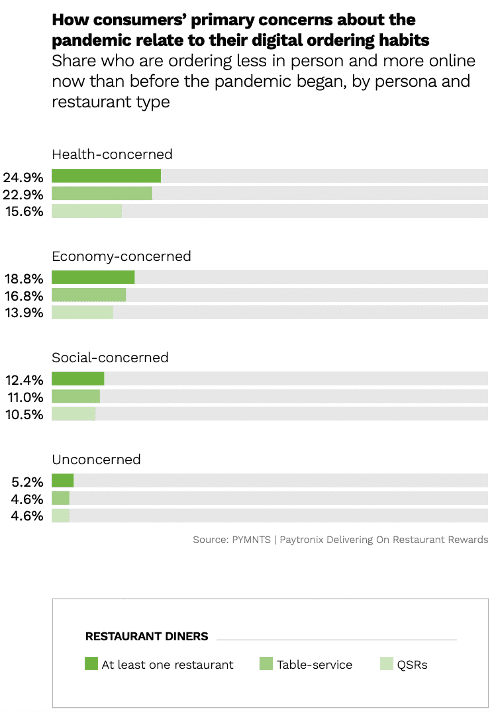
As the restaurant industry begins to recover, many people, vaccinated and otherwise, are still dealing with concerns related to the pandemic — and those concerns are shaping their ordering behaviors. As PYMNTS’ research published in the May edition of Delivering on Restaurant Rewards created in collaboration with Paytronix has identified, there are four main personas of today’s restaurant customer: the health-concerned customer, the economy-concerned customer, the social-concerned customer and the unconcerned customer. As one might expect, the digital ordering habits of the health-concerned look very different than, say, those of the social-concerned.

No Touching
As one might expect, the health-concerned customer is more likely than any other persona to be willing to spend more on a food order if they can order and pay online, order via an app or pick up their order at a drive-thru, in an in-store fast lane or curbside. These low-contact capabilities allow the health-concerned customers, who account for 39 percent of all restaurant customers, to get their meals without much fear of contagion.
However, this does not necessarily mean that restaurants’ savviest move would be to target all of their digital offerings at these health-concerned customers. This persona is also the most likely to be interested in returning to in-person ordering post-inoculation. Given that nearly 40 percent of all U.S. adults are now fully vaccinated, this group’s enthusiasm for digital ordering may wane in the near future.
Coupon Clippers
Notably, economy-concerned customers, who make up 27 percent of the dining population, actually report that online ordering ability is the single feature that would most encourage them to spend more on food orders. This may come in part from the convenience of the channel, which allows easier transactions for those who may be focused on getting through a busy workday. Restaurants targeting the thrifty can drive spend by investing in easy-to-use (and easy-to-find) digital ordering features.
Many of the major quick-service restaurant (QSR) chains, which often target more budget-minded customers, have been noting the interest in these digital channels, finding ways to guide customers towards their digital apps. Take, for instance, Chipotle Mexican Grill’s highly publicized release of its digital-only menu item, directing customers toward its web and mobile ordering channels.
All Together Now
Social-concerned restaurant customers, representing 22 percent of diners, are not as interested in digital ordering capabilities as their health- and economy-concerned counterparts. About a third of these consumers would be willing to pay more for the ability to order online — their most in-demand feature — but only 12 percent of these restaurant customers have been ordering less in person and more online since the start of the pandemic.
Online ordering, of course, tends to be fairly off-premises-heavy, though many tech providers are offering ways to integrate digital ordering capabilities into the in-restaurant experience. Ultimately, these customers are more interested in what happens when they are in the restaurant with their friends and family than in what their pickup/delivery ordering experience looks like.
This Is Fine
When it comes to digital ordering, restaurants won’t get much from the unconcerned customer. Only one in 20 of these customers has turned more toward digital ordering channels since the start of the pandemic. While unconcerned customers are in fact quite likely to engage with restaurants’ loyalty programs, with 46 percent of unconcerned diners using loyalty programs with at least one restaurant (typically a QSR), they are not particularly bothered about how they place their order.
Ultimately, digital ordering remains mostly the purview of those whose ordering behavior is shaped by their health or financial concerns. With contact-free technologies, frictionless features, and digital deals and discounts, restaurants can capture the online ordering habits of these concerned consumers.